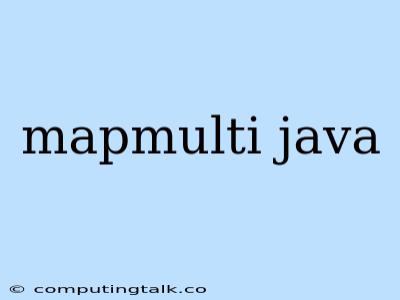Understanding and Implementing MapMulti in Java
The MapMulti interface in Java provides a powerful mechanism for managing multiple values associated with a single key. This is especially useful when you need to store collections of data against a specific identifier, like a user ID, a product ID, or any other key that can have multiple associated values.
What is a MapMulti?
At its core, a MapMulti in Java acts as a mapping structure. It allows you to store key-value pairs. However, unlike a regular Map that associates a single value with each key, a MapMulti allows you to associate multiple values with a single key. These multiple values are often grouped together as a collection, such as a List or a Set.
Why Use MapMulti?
Here's why the MapMulti interface can be a valuable tool in your Java development:
-
Organizing Related Data: If you need to store multiple pieces of data related to a specific key,
MapMultiprovides a clear and structured way to do so. For instance, imagine storing the different orders placed by a particular customer (the key) using aMapMulti. Each customer ID can then have a collection of their orders associated with it. -
Flexible Data Handling:
MapMultigives you flexibility in how you manage your values. You can choose the type of collection that best suits your needs, whether it's aListfor maintaining order, aSetfor ensuring uniqueness, or any other collection type. -
Efficient Data Retrieval:
MapMultioffers efficient methods for accessing and retrieving the associated values for a given key. You can easily iterate through the collection of values or retrieve specific values using methods likegetorgetAll.
How to Implement MapMulti in Java
While Java doesn't have a built-in MapMulti interface, there are several ways to achieve this functionality using existing Java libraries and concepts:
1. Utilizing a Map with Collections as Values:
This is a common and straightforward approach. You use a regular Map and store collections as the values.
import java.util.HashMap;
import java.util.List;
import java.util.ArrayList;
public class MapMultiExample {
public static void main(String[] args) {
HashMap> customerOrders = new HashMap<>();
// Adding orders for customer "Alice"
List aliceOrders = new ArrayList<>();
aliceOrders.add("Product A");
aliceOrders.add("Product B");
customerOrders.put("Alice", aliceOrders);
// Adding orders for customer "Bob"
List bobOrders = new ArrayList<>();
bobOrders.add("Product C");
customerOrders.put("Bob", bobOrders);
// Retrieving orders for "Alice"
List ordersForAlice = customerOrders.get("Alice");
System.out.println("Alice's Orders: " + ordersForAlice);
}
}
2. Using Third-Party Libraries:
Libraries like Apache Commons Collections provide the MultiMap interface, which offers similar functionality to MapMulti.
3. Implementing a Custom MapMulti Interface:
You can create your own custom MapMulti interface tailored to your specific requirements. However, this approach requires more coding effort.
Important Considerations
- Data Type Consistency: Ensure that the values stored in a
MapMultiare consistent with the chosen collection type. If you're using aList, all values associated with a key should be of the same type. - Performance: While
MapMultioffers flexibility, it's crucial to consider performance implications. If you need to access data frequently, using aMapwith Collections as values is a relatively efficient approach. - Choosing the Right Library: When using third-party libraries, carefully evaluate the features and performance characteristics of the
MultiMapimplementation you choose.
Examples of Using MapMulti
Here are some real-world examples of how MapMulti can be used:
- Product Catalog: Maintain a
MapMultiwhere the key is a product category and the values are a list of products belonging to that category. - Social Network: Store a
MapMultithat maps user IDs to lists of their friends. - Event Management: Create a
MapMultithat maps event IDs to lists of attendees.
Conclusion
The MapMulti concept in Java allows you to work with key-value pairs where each key can be associated with multiple values. This powerful functionality is particularly useful when you need to organize and manage collections of related data. By choosing the right implementation method, you can leverage the benefits of MapMulti to enhance the structure and flexibility of your Java applications.
